Phthiraptera: Lice
(from the Greek: phthir = lice + aptera = wingless)
Lice are tiny, flattened, wingless insects with soft bodies and incomplete metamorphosis. All lice are external parasites of birds  a
a nd mammals. Lice antennae are short, and the eyes are absent or poorly developed. Most lice are host specific; that is, each louse species will live on only one kind of host, and the entire life cycle is spent on the host animal. The eggs (called “nits”) are glued to the host's hair or feathers.
nd mammals. Lice antennae are short, and the eyes are absent or poorly developed. Most lice are host specific; that is, each louse species will live on only one kind of host, and the entire life cycle is spent on the host animal. The eggs (called “nits”) are glued to the host's hair or feathers.
There are two main groups of lice: chewing lice and sucking lice. Chewing lice have chewing mouthparts and feed on the hair or feathers and skin of their host. Although chewing lice can cause much irritation, they do not spread disease organisms as do the sucking lice. Sucking lice feed on blood, and often transmit diseases between organisms. No species of chewing lice are parasitic on humans, but there are several types of sucking lice (body, head, and crab lice) that attack humans.

